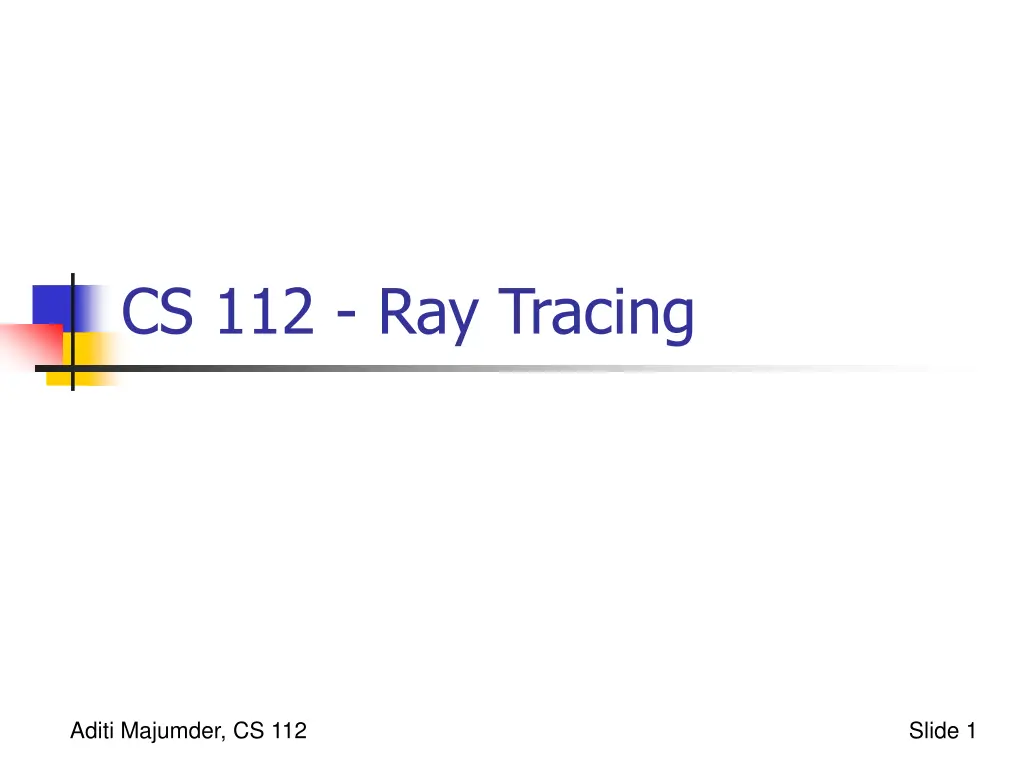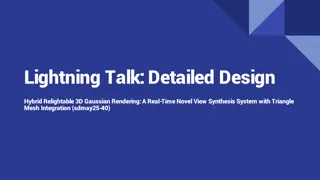
Understanding Ray Tracing Techniques
Explore the principles of ray tracing in computer graphics, including limitations of illumination accuracy, direct and indirect illumination, reflected and refracted rays, recursive ray tracing, managing recursion, and intersection calculations. Discover how rays interact with spheres and triangles to create realistic images.
Download Presentation

Please find below an Image/Link to download the presentation.
The content on the website is provided AS IS for your information and personal use only. It may not be sold, licensed, or shared on other websites without obtaining consent from the author. If you encounter any issues during the download, it is possible that the publisher has removed the file from their server.
You are allowed to download the files provided on this website for personal or commercial use, subject to the condition that they are used lawfully. All files are the property of their respective owners.
The content on the website is provided AS IS for your information and personal use only. It may not be sold, licensed, or shared on other websites without obtaining consent from the author.
E N D
Presentation Transcript
CS 112 - Ray Tracing Aditi Majumder, CS 112 Slide 1
Illumination is not accurate sflake Cannot capture the effects of refraction, transparency and translucency accurately. Aditi Majumder, CS 112 Slide 2
Direct and Indirect Illumination Capture only direct illumination Light coming directly from light Light bounces from other objects in the scene Aditi Majumder, CS 112 Slide 3
Ray Tracing Reflected ray Start from the light and find how each ray is getting reflected to from different objects to reach the viewer Exponentially complex problem Reverse operation Start from the viewer and see how a particular ray has traveled Refracted ray Aditi Majumder, CS 112 Slide 4
Ray Tracing Casts one ray per pixel Casts a bunch of ray in the scene Find out how the ray traverses Aditi Majumder, CS 112 Slide 5
Recursive Ray Tracing Ray hits an object at P Cast a shadow ray S from P to each light If shadow ray does not intersect any other object, calculate direct illumination from light IL Cast a reflected ray R from P and find its contribution, IR Cast a refracted ray T from P and find its contribution, IT C = wLIL+wRIR+wTIT Aditi Majumder, CS 112 Slide 6
How to stop the recursion? If a ray has travelled beyond A threshold distance A threshold number of hops Energy is the ray has fallen beyond a certain threshold Aditi Majumder, CS 112 Slide 7
Intersections (Ray-Sphere) |P-Pc|2 r2 = 0 P = P0 + t(P1-P0) |P0-Pc + t(P1-P0)|2 r2 = 0 Will give you a quadratic equation to solve for t P0 P1 P r Pc Aditi Majumder, CS 112 Slide 8
Ray-Triangle Intersection V0, V1, V2 Triangle V0 + u(V1-V0) + v(V2-V0) P0, P1 - Ray P0 + t(P1-P0) Intersection point I, such that V0 + u(V1-V0) + v(V2-V0) = P0 + t(P1-P0) u(V1-V0) + v(V2-V0) + t(P0-P1) = P0-V0 uA + vB + tC = D 3D vectors Aditi Majumder, CS 112 Slide 9
Ray Triangle Intersection Ax Bx Cx Ay By Cy Az Bz Cz u v t Dx Dy Dz = -1 u v t Ax Bx Cx Ay By Cy Az Bz Cz Dx Dy Dz = Aditi Majumder, CS 112 Slide 10
Antialiasing Shoot more than one ray through the pixels Super-sampling Average their contribution Filtering Aditi Majumder, CS 112 Slide 11

